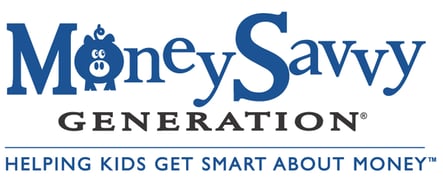Business Education | Career Readiness | Personal Finance | Middle School
4 Best Financial Literacy Curriculum Options for Middle School
For nearly 10 years, Bri has focused on creating content to address the questions and concerns educators have about teaching classes, preparing students for certifications, and making the most of the iCEV curriculum system.
Financial literacy has become an increasingly popular topic in middle school business and career readiness programs. Unfortunately, personal finance isn’t a particularly engaging topic to discuss with middle schoolers. That means you need to find a personal finance curriculum that meets your standards, is easy to implement, age-appropriate, and interesting for your students.
While we provide personal finance lessons as part of our business and career readiness curriculum, teachers sometimes ask us for other financial literacy resource recommendations.
In this article, you’ll learn about four financial literacy curriculum options we often hear about from middle school teachers like you:
- EverFi
- Next Gen Personal Finance
- Money Savvy Generation
- Practical Money Skills
After reading this article, you’ll feel more confident in understanding which personal finance curriculum option would work best for you and your students.
1. EverFi

EverFi is a digital curriculum provider for K-12 educators covering various subjects, including financial education, health and wellness, college and career readiness, and social-emotional learning.
Their goal is to help teachers bring “real-world learning” to the classroom by implementing digital resources that focus on skills students will need to succeed in the long run.
What Middle School Resources Does EverFi Provide?
For middle school students, EverFi partnered with The MassMutual Foundation to develop a digital course called FutureSmart.
The FutureSmart course helps students learn to manage finances effectively, make good decisions, and become financially responsible.
In the FutureSmart course, your students will go through seven online lessons:
- Welcome Mayor!
- Smart Shopping
- Ways to Pay
- Investing in You
- Growing a Business
- Your Financial Future
- Build Your Blueprint
Along with the student-led lessons, EverFi includes teacher resources such as supplemental lesson plans, alignment guides, answer keys, and discussion guides.
How Much Does EverFi Cost?
EverFi’s financial education resources are free for educators who register on their website.
Who is the EverFi Middle School Financial Literacy Content a Good Fit for?
EverFi notes that the FutureSmart course is designed for Economics, Business, Social Studies, or Career Readiness classes.
With 7 lessons, each 25 minutes long, the FutureSmart course will take your students around 4 class periods to complete. If you choose to assign one lesson per day, you could stretch the FutureSmart course to take 7 class periods to complete.
If you need a personal finance curriculum resource to implement as a small part of your business or career course, the EverFi FutureSmart course could be a great option.
2. Next Gen Personal Finance

Next Gen Personal Finance (NGPF) is an online non-profit organization that provides educational resources to business and personal finance teachers.
To accomplish this, NGPF has a variety of games, interactive activities, and curriculum options for middle and high school teachers to implement.
What Middle School Resources Does NGPF Provide?
NGPF provides a 9-week middle school course that helps teachers introduce personal finance topics to 6th to 8th grade students.
The NGPF middle school personal finance curriculum includes nine units:
- Money in Our Lives
- Consumer Skills
- Budgeting
- Credit
- Saving
- Investing
- Protecting Yourself
- Prepare for Success
- Life After High School
Each unit includes student activity packets, Nearpod lessons, assessments, and a slide deck you can use to discuss the material.
Teachers will also find unit and lesson plan documents and answer keys for the various assessments students complete throughout the course.
How Much Does the NGPF Curriculum Cost?
All of the educational resources from Next Gen Personal Finance are free for teachers to access. However, you will need to create a free teacher account for full access to the assessments and answer keys.
Who is the NGPF Middle School Course a Good Fit for?
Overall, the NGPF middle school curriculum is a straightforward resource for any teacher to implement.
If you need to teach a 9-week middle school personal finance course, Next Gen Personal Finance could be just the right fit for you.
3. Money Savvy Generation

Susan Beacham founded Money Savvy Generation to teach children basic money management skills.
They provide various products for both parents and educators, ranging from banks and handbooks to learning games and curriculum resources.
What Middle School Resources Does Money Savvy Generation Provide?
To help middle school teachers implement personal finance in their classrooms, Money Savvy Generation created a personal finance curriculum called “Money Savvy U.”
Specifically, Money Savvy U includes seven lessons to help middle school students get off on the right foot with their finances:
- Budgeting
- Power of Compounding
- Smart Spending
- Smart Borrowing and Use of Credit Cards
- Smart Investing
- Ways to Pay
- Identity Protection
The materials provided for the lessons include animated presentations, teaching scripts, classroom exercises, student handouts, teacher guides, and budgeting templates.
You’ll also find a Prezi-based game called “Do You Think Like a Millionaire” to further expand on the topics covered in the lessons.
How Much Does Money Savvy U Cost?
It costs $39.95 to purchase the USB flash drive with all the instructor materials needed to implement Money Savvy U in your classroom.
For an additional $24.95, you can purchase the “Are U Money Savvy?” Worksheet Bundle to further supplement your curriculum.
Who is Money Savvy U Good Fit for?
In total, Money Savvy U may fill between five and seven class periods, depending on how in-depth you go with the discussions and classroom exercises.
If you want a supplemental financial literacy curriculum that is mainly teacher-led, Money Savvy U could be a good choice for you.
4. Practical Money Skills

Practical Money Skills is a financial literacy program created by Visa to help individuals develop good money management skills.
Their audience ranges from Pre-K to adults, with a variety of personal finance resources available for all age groups.
What Middle School Resources Does Practical Money Skills Provide?
For middle school courses, Practical Money Skills provides 14 lessons:
- Making Decisions
- Making Money
- The Art of Budgeting
- Living on your Own
- Buying a Home
- Banking Services
- Credit
- Credit Cards
- Cars and Loans
- The Influence of Advertising
- Consumer Awareness
- Saving and Investing
- In Trouble
- Consumer Privacy
Each lesson includes two primary resources: a teacher’s guide and a student activities document.
The teacher’s guide includes lesson objectives, teaching standards, and step-by-step instructions for each lesson (including what presentation slides to show at specific points in time).
The student activities document includes worksheets and other handouts for students to complete as they go through the lessons.
How Much Does Practical Money Skills Cost?
Practical Money Skills offers their middle school lessons free to anyone and doesn’t require you to create an account to access them.
Who is Practical Money Skills a Good Fit for?
The middle school resources from Practical Money Skills are the most open-ended and don’t indicate how long the lessons and activities will take.
That can make planning difficult; however, it also allows you more flexibility when implementing the pieces compared to other items on the list.
If you’re looking for flexible resources that you can pick and choose from to build a financial literacy curriculum, Practical Money Skills might be the right choice for you.
Which Financial Literacy Curriculum Resources Are Right for You?
Deciding on one of these resources depends on your specific needs for a financial literacy curriculum. Based on how much content you need to teach, one of these curriculum resources might be a better fit than others.
If you need to fill a full middle school personal finance course, Next Gen Personal Finance will likely be the best option for you.
If you’re looking for supplemental resources to incorporate personal finance in classes, check out EverFi, Money Savvy, or Practical Money Skills.
However, you may consider a well-rounded CTE curriculum that includes personal finance, such as iCEV. A comprehensive curriculum allows you to teach personal finance alongside other business and career readiness topics like professional communication and entrepreneurship.
To discover more about iCEV and if it’s right for your students, visit the Business, Marketing, Finance, IT, and Media curriculum page. You’ll be able to see the complete catalog of courses to help you decide:


